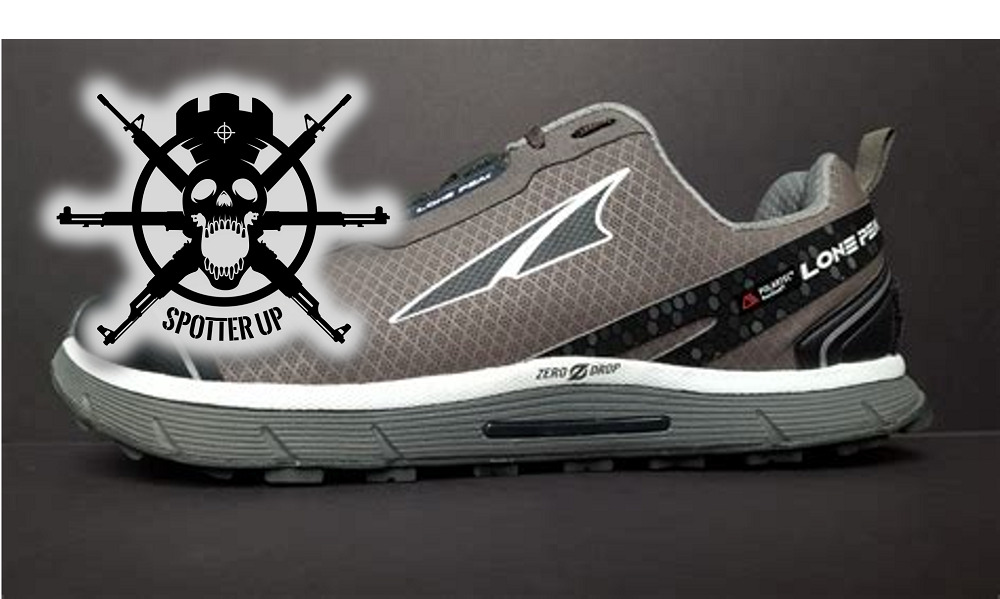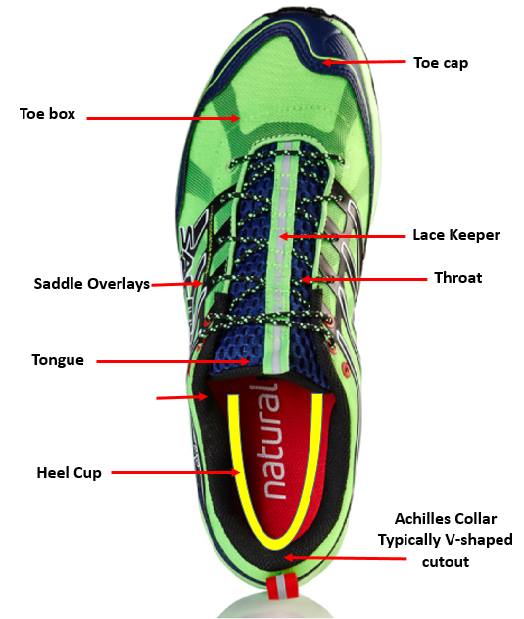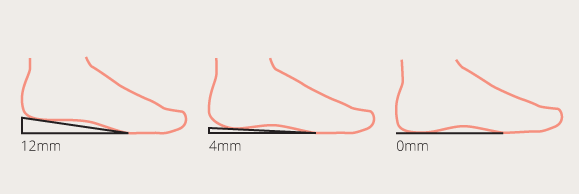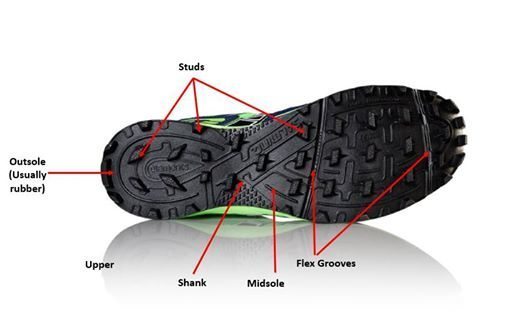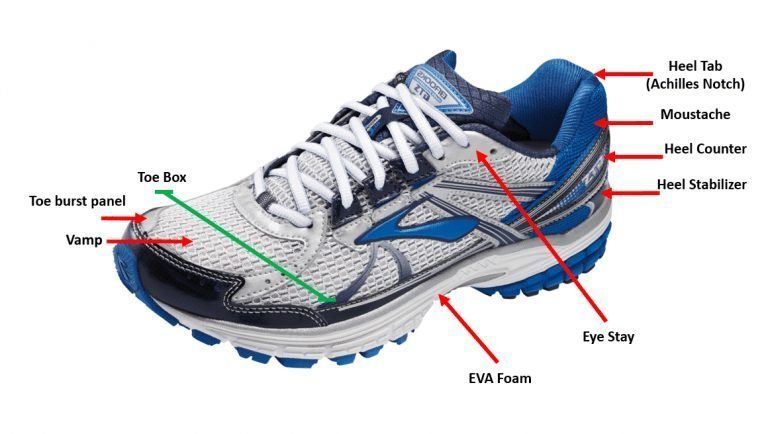Understanding the structural features of a shoe can help you understand what qualities to look for in a shoe before you purchase a pair, the indicators to look for when before replacing them, and what kind of shoes will fit your feet. Finding the right pair of shoes is crucial for an athlete and particularly those who run. Here is a glossary of commonly used terms. These terms have been cobbled together from running sites.
COLLAR: The inside back portion of the shoe that provides stability around the ankle. Some people like a stiffer collar while others may like it to be less rigid. Some collars can irritate the ankle.
COLLAR LINING: The part of the collar that provides comfort around the ankle. Some manufacturers use a plusher collar and lining while others may have a leaner collar in order to cut down on weight. Minimalist shoes tend to be leaner. The Brooks Adrenaline for example has a plusher collar while the Altras Torin does not.
DUAL-DENSITY MIDSOLE: A mechanism, most often a firmer wedge of foam on the medial (inner) side of the shoe, used to correct excessive pronation. Many zero drop shoes do not have this feature.
DOUBLE STITCH: Two lines of stitching to provide the shoe the best construction.
DROP: This is the center of the heel and center of the forefoot; the midsole and outsole are included. Shoes with a smaller drop allow your heel and forefoot to touch the ground at the same time, and therefore make your push off more responsive. Minimal shoes are generally “zero drop”.
EVA: Ethylene-vinyl acetate foam. EVA is a flexible, lightweight and soft foam.
EYELET: The eyelets are the holes the shoelaces pass through. The eyelets of a running shoe should be large enough and smooth enough so you can easily and quickly adjust your laces.
EYESTAY: The material that provide structure to the eyelets. Generally made of a sturdy fabric so that a lace will not tear through the eyelet.
FLEX GROOVES: Channels that help the shoe flex along with the natural movement of the foot. The combination of pods, studs and features such as the flex grooves can determine how responsive a shoe is during your activities.
GEL CUSHIONING: Cushioning materials are often added to the heel and forefoot of running shoes to help attenuate the landing shock and loading forces experienced by the body while running.
HEEL CUP: This is heel portion of the insole of your shoe. A good heel cup can prevent your foot from sliding. Those with thin feet should look for smaller sizes in a shoe such as AA instead of B or D.
HEEL COLLAR: The heel collar (sometimes called heel cuff) forms the top of the shoe, supporting the heel and Achilles tendon. The collar prevents the foot from slipping inside the shoe and makes it more stable to run in. When purchasing a shoe ensure the collar does not irritate your ankle by first testing out a pair of shoes.
HEEL STABILIZER: The heel stabilizer/counter is the internal plastic structure of the shoe which wraps around the heel of your foot. It holds the heel in position during the movements of running. An internal support feature in the rear of the shoe that conforms to the shape of your heel. The shoe pattern parts that surrounds the heel should have a stiff reinforcement.
HEEL NOTCH: A relief cut that allows the runner to flex and bends without the shoe rubbing on the Achilles tendon. Also called Achilles tendon protector or Achilles tendon notch.
LAST: The last is a layer of material which is stitched to the upper. The sockliner is placed on top of the last.
LACE KEEPER: A small flap that holds the tongue in place.
MEDIAL POST: Located on the inside part of the shoe, this is placed to help you reduce over-pronation. Medial post are made from EVA,that is denser material than the midsole. It also helps you with stability.
MIDSOLE: The midsole is a layer of spongy material between the outsole and the upper. These cushioning materials combine bounce and durability. The material (usually EVA or Polyurethane foam) that sits below the upper and above the outsole, providing protection from impact forces and oftentimes encasing nonfoam technologies, such as GEL or Air, to increase durability and protection.
MUDGUARD: The Mudguard is the shoe pattern part along the forward part of the shoe alone the edge of the outsole. Good protection for limiting wear from abrasive items such as rocks, branches and street. Trail shoes tend to have good guards.
MUSTACHE: Added material to give the structure.
OUTSOLE: The outsole makes up the base of the running shoe. The outsole is the durable part of the shoe that makes contact with the ground, providing traction.
OVERLAYS: Reinforcing strips at key stress points that help give the shoe structure.
http://www.youtube.com/watch?v=cuJr7DPvQqQ
PULLTAB: Fabric that helps you pull your shoe quickly over your foot.
QUARTER PANEL: The Quarter Panel is the main shoe pattern part on the side of the shoe pattern. The Nike Swoosh, New Balance N and the Vans V-Bar are all located on the quarter panel. The material that makes up the sides of the shoe.
SADDLE OVERLAYS: Material that dresses the quarter panel up but also adds more structure to the shoe.
SHOE LACE: –
SHANK: Purpose is to stiffens the shoe under the arch, which makes the middle portion of the shoe firmer (minimalist shoes doesn’t have it). Some of them wraps the shank up to the medial post part of the shoe to add more stability and thus allowing it to function more like a medial post. Minimalist shoes may not have a shank.
SPACE TRUSSTIC: The Space Trusstic is a plastic bridge with a space behind it found under the arch section of the shoe. The Trusstic gives the shoe strength and stability, without sacrificing flexibility.
SOCKLINER: The sockliner (also called insole) is the first layer of soft foam which your foot rests on inside the running shoe. A removable insert that sits just below the foot and helps the shoe better fit the foot.
TONGUE: Soft elongated flap that fits over the top of the foot to protect the tendons and blood vessels from pressure caused by the laces. The tongue is a separate strip on the upper. It makes it easier to put your shoes on and take them off. It also prevents the laces from rubbing against the instep of your foot.
TOE-BOX: The front part of the shoe; the space around the toes. Look for a toe box with a wide enough area for your fore-foot. Nike’s tend to be narrow, while Brooks generally are taller and wider than other brands. Both brands offer wider sizes in 2EE and 4EE.
TOE TIP/CAP: Thin rubber strip from the outsole with a stitch to hold it on to the upper.
TOE BURST PANEL: Reinforces the vamp to prevent the big toe nail from tearing the vamp.
THROAT: The opening of a shoe. Ensure you get a shoe with a wide enough throat for your foot.
UPPER: The upper is the top part of the shoe, designed to firmly hold your foot in place inside the shoe. Breathable mesh is the best.
VAMP: The running shoe vamp should be soft, flexible and breathable.
Follow our regular channel at Spotterup on YouTube
Follow our WEBSITE
Follow on Instagram
Visit our STORE
*The views and opinions expressed on this website are solely those of the original authors and contributors. These views and opinions do not necessarily represent those of Spotter Up Magazine, the administrative staff, and/or any/all contributors to this site.
